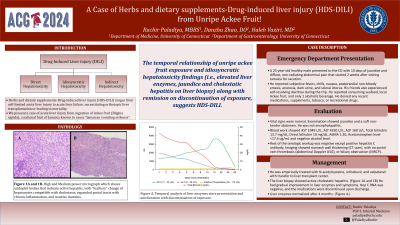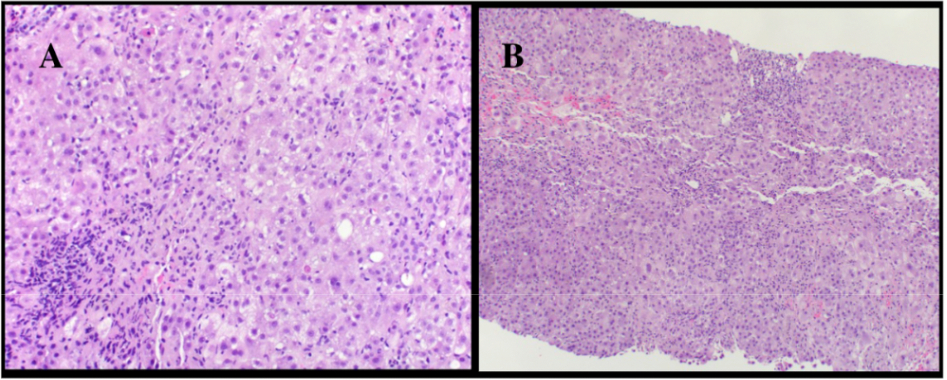Tuesday Poster Session
Category: Liver
P4847 - A Case of Herbs and Dietary Supplements-Drug-Induced Liver Injury From Unripe Ackee Fruit!
Tuesday, October 29, 2024
10:30 AM - 4:00 PM ET
Location: Exhibit Hall E

Has Audio

Ruchir Damjibhai Paladiya, MBBS
University of Connecticut Health Center
Hartford, CT
Presenting Author(s)
Ruchir Damjibhai. Paladiya, MBBS1, Danzhu Zhao, DO2, Haleh Vaziri, MD2
1University of Connecticut Health Center, Hartford, CT; 2University of Connecticut Health Center, Farmington, CT
Introduction: Herbs and dietary supplements-Drug-induced liver injury (HDS-DILI) ranges from self-limited acute liver injury to acute liver failure, necessitating orthotopic liver transplantation or leading to mortality. We present a case of acute liver injury from ingestion of Ackee fruit (Blighia sapida), a national fruit of Jamaica known to cause “Jamaican vomiting sickness”.
Case Description/Methods: A 25-year-old healthy male presented to the ED with 10 days of jaundice and diffuse, non-radiating abdominal pain that started 2 weeks after visiting Jamaica for vacation. He reported subjective fevers, chills, nausea, postprandial non-bloody emesis, anorexia, dark urine, and scleral icterus. His friends also experienced self-resolving diarrhea during the trip. He reported consuming seafood, local Ackee fruit, and only 1 alcoholic beverage. He denied any recent medications, supplements, tobacco, or recreational drugs. Vital signs were normal. Examination showed jaundice and a soft non-tender abdomen. He was not encephalopathic. Blood work showed AST 1949 U/L, ALT 4330 U/L, ALP 160 U/L, Total bilirubin 13.7 mg/dL, Direct bilirubin 10 mg/dL, ASMA 1:20, Acetaminophen level < 17.4 ug/mL and negative alcohol level. Rest of the serologic workup was negative except positive hepatitis C antibody. Imaging showed stomach wall thickening (CT scan), with no portal vein thrombosis (abdominal Doppler USG), or biliary obstruction (MRCP). He was empirically treated with N-acetylcysteine, sofosbuvir, and velpatasvir with transfer to liver transplant center. The liver biopsy showed active cholestatic hepatitis. He had gradual improvement in liver enzymes and symptoms. Hep C RNA was negative and the medications were discontinued upon discharge. Liver enzymes normalized after 4 months.
Discussion: The edible portion of the ackee fruit, aril, contains water-soluble toxins, hypoglycin A and B. As the fruit ripens, their concentration drops to safe levels. These toxins impair gluconeogenesis and beta-oxidation of fatty acids, resulting in hypoglycemia. However, the exact mechanism of idiosyncratic hepatotoxicity remains unknown. Our patient's HDS-DILI was presumed due to the temporal relationship of unripe ackee fruit exposure with elevated liver enzymes, jaundice and liver biopsy findings along with remission on discontinuation of exposure. The fruit is only available in canned forms with import restrictions. We aim to highlight its potential toxicity and heighten clinical suspicion in relevant contexts.

Disclosures:
Ruchir Damjibhai. Paladiya, MBBS1, Danzhu Zhao, DO2, Haleh Vaziri, MD2. P4847 - A Case of Herbs and Dietary Supplements-Drug-Induced Liver Injury From Unripe Ackee Fruit!, ACG 2024 Annual Scientific Meeting Abstracts. Philadelphia, PA: American College of Gastroenterology.
1University of Connecticut Health Center, Hartford, CT; 2University of Connecticut Health Center, Farmington, CT
Introduction: Herbs and dietary supplements-Drug-induced liver injury (HDS-DILI) ranges from self-limited acute liver injury to acute liver failure, necessitating orthotopic liver transplantation or leading to mortality. We present a case of acute liver injury from ingestion of Ackee fruit (Blighia sapida), a national fruit of Jamaica known to cause “Jamaican vomiting sickness”.
Case Description/Methods: A 25-year-old healthy male presented to the ED with 10 days of jaundice and diffuse, non-radiating abdominal pain that started 2 weeks after visiting Jamaica for vacation. He reported subjective fevers, chills, nausea, postprandial non-bloody emesis, anorexia, dark urine, and scleral icterus. His friends also experienced self-resolving diarrhea during the trip. He reported consuming seafood, local Ackee fruit, and only 1 alcoholic beverage. He denied any recent medications, supplements, tobacco, or recreational drugs. Vital signs were normal. Examination showed jaundice and a soft non-tender abdomen. He was not encephalopathic. Blood work showed AST 1949 U/L, ALT 4330 U/L, ALP 160 U/L, Total bilirubin 13.7 mg/dL, Direct bilirubin 10 mg/dL, ASMA 1:20, Acetaminophen level < 17.4 ug/mL and negative alcohol level. Rest of the serologic workup was negative except positive hepatitis C antibody. Imaging showed stomach wall thickening (CT scan), with no portal vein thrombosis (abdominal Doppler USG), or biliary obstruction (MRCP). He was empirically treated with N-acetylcysteine, sofosbuvir, and velpatasvir with transfer to liver transplant center. The liver biopsy showed active cholestatic hepatitis. He had gradual improvement in liver enzymes and symptoms. Hep C RNA was negative and the medications were discontinued upon discharge. Liver enzymes normalized after 4 months.
Discussion: The edible portion of the ackee fruit, aril, contains water-soluble toxins, hypoglycin A and B. As the fruit ripens, their concentration drops to safe levels. These toxins impair gluconeogenesis and beta-oxidation of fatty acids, resulting in hypoglycemia. However, the exact mechanism of idiosyncratic hepatotoxicity remains unknown. Our patient's HDS-DILI was presumed due to the temporal relationship of unripe ackee fruit exposure with elevated liver enzymes, jaundice and liver biopsy findings along with remission on discontinuation of exposure. The fruit is only available in canned forms with import restrictions. We aim to highlight its potential toxicity and heighten clinical suspicion in relevant contexts.

Figure: Figure 1A and 1B. High and Medium power micrograph which shows acidophil bodies that indicate active hepatitis, with “feathery” change of hepatocytes compatible with cholestasis, expanded portal tracts with chronic inflammation, and reactive ductules.
Disclosures:
Ruchir Paladiya indicated no relevant financial relationships.
Danzhu Zhao indicated no relevant financial relationships.
Haleh Vaziri indicated no relevant financial relationships.
Ruchir Damjibhai. Paladiya, MBBS1, Danzhu Zhao, DO2, Haleh Vaziri, MD2. P4847 - A Case of Herbs and Dietary Supplements-Drug-Induced Liver Injury From Unripe Ackee Fruit!, ACG 2024 Annual Scientific Meeting Abstracts. Philadelphia, PA: American College of Gastroenterology.

